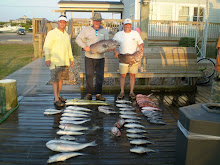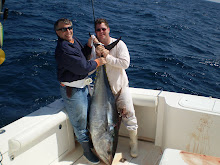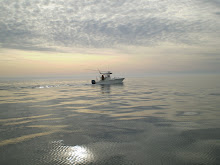
By Jim Field
This summer Peter Wann (photo at left on the Sea Ya Bea off Hatteras) loaned me a wahoo rig from his tackle box so that I could reverse-engineer (i.e., copy) it. Sad to say, but up to this point in time (5 years deep sea fishing), I couldn't claim knowledge of how to build a genuine wire rig, and thus didn't have one onboard for routine use in catching wahoo--unquestionably my favorite pelagic fish to eat. So while on vacation, I spent an afternoon preparing four rigs for the Sea Ya Bea, one of which was immediately--and successfully--deployed in landing a wahoo on a trip with Dan. Note to readers: mission accomplished!
Peter has mated on a number of charter boats out of Hatteras Village, and he knows his stuff; accordingly, his rig is "tried and true" and should be treated with the appropriate respect due gear known to work and get the job done. As the photos below demonstrate, the rig is simple yet elegant--100% functionality with no frills attached. Jon: hope it brings you good luck too, my friend.
Materials:
- #7 forged steel J hook (may prefer stainless)
- #9 or #10 wire, 30-50 foot section (depends upon desired length of leader)
- lead egg weight of choice
- bally rigging wire or spring
- skirt of choice (black/red for wahoo typically preferred)
Steps: (refer to photos below)
(1) pass bitter end of wire through eye of hook and double back
(2) make haywire twist approximately 2-3 inches in length, as determined by desired span between eye of hook and wire rigging post for passing through bally's beak
(3) slide egg weight onto other end of wire and down over haywire twist to point of desired distance from hook's eye
(4) make 3-4 tight circular twists with wire
(5) position wire to point "north" relative to J hook
(6) clip off wire end to create rigging post of desired length
(7) slide rigging spring down other end of wire, tapered cone pointing away from hook
(8) or attach rigging wire through eye of egg weight with twist
(9) slide skirt down wire in correct trolling direction
(10) make haywire twist in bitter end of leader



Steve Wann (Peter's dad) with 20 pound wahoo caught on photographed rig, last week of July 2010, on the Sea Ya Bea, inside the Rockpile, Hatteras

Dan with wahoo caught on copied rig made by Jim, first week of August 2010, on the Sea Ya Bea, southwest of Rockpile, Hatteras












